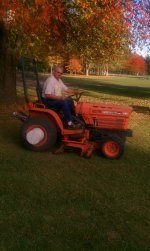Scotty Dive
Veteran Member
here is my .02 cents for rim guard versus weights:
1. My turf tires are loaded - about 450 - 500 pounds. No problem to install and remove them. If they fall over while rolling them - let them. I am 170 pounds and can tip them back up. You always have the weight on the tractor and it provides great stability and a lower center of gravity. Do they mash down my lawn - yes - but after a few days - no problem. If I get a hole in one...I put the hole at the top and plug. It does put less stress versus weights on the bearings if that is a concern for you - but it doesn't bother me. Its nice to have the stability and the weight when doing light loader work.
2. Wheel weights - very expensive (in metal) to get an equivalent amount of weight on the rim and a pain in the neck to man handle when installing and removing. They are so dense that crushed fingers and toes are a distinct possibility. If I had to remove the tires - I would have to remove the weights first and then the tire. Otherwise - I am guessing here....the tires with the weights still mounted would be very much off balanced and difficult to roll to a safe place If they tipped over - since the weight is concetrated towards the center of the rim - it would take a lot of strenght to stand them back up again.
1. My turf tires are loaded - about 450 - 500 pounds. No problem to install and remove them. If they fall over while rolling them - let them. I am 170 pounds and can tip them back up. You always have the weight on the tractor and it provides great stability and a lower center of gravity. Do they mash down my lawn - yes - but after a few days - no problem. If I get a hole in one...I put the hole at the top and plug. It does put less stress versus weights on the bearings if that is a concern for you - but it doesn't bother me. Its nice to have the stability and the weight when doing light loader work.
2. Wheel weights - very expensive (in metal) to get an equivalent amount of weight on the rim and a pain in the neck to man handle when installing and removing. They are so dense that crushed fingers and toes are a distinct possibility. If I had to remove the tires - I would have to remove the weights first and then the tire. Otherwise - I am guessing here....the tires with the weights still mounted would be very much off balanced and difficult to roll to a safe place If they tipped over - since the weight is concetrated towards the center of the rim - it would take a lot of strenght to stand them back up again.
